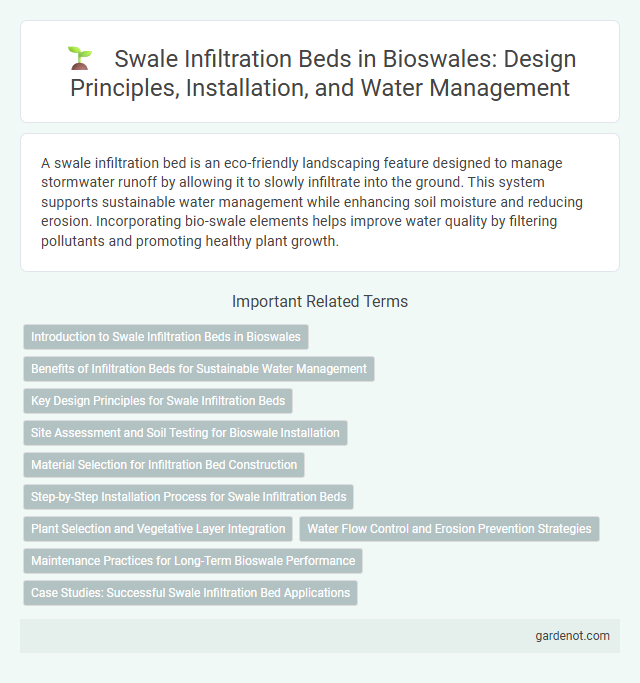A swale infiltration bed is an eco-friendly landscaping feature designed to manage stormwater runoff by allowing it to slowly infiltrate into the ground. This system supports sustainable water management while enhancing soil moisture and reducing erosion. Incorporating bio-swale elements helps improve water quality by filtering pollutants and promoting healthy plant growth.
Introduction to Swale Infiltration Beds in Bioswales
Swale infiltration beds are engineered landscape features designed to enhance stormwater management by promoting groundwater recharge and reducing surface runoff. These beds utilize permeable soils and vegetation to filter pollutants, increase infiltration rates, and support sustainable urban drainage systems within bioswales. Properly designed swale infiltration beds improve water quality and mitigate flooding risks by slowing and capturing stormwater flow.
Benefits of Infiltration Beds for Sustainable Water Management
Swale infiltration beds enhance sustainable water management by promoting groundwater recharge and reducing surface runoff, which mitigates flooding and erosion. These systems improve water quality by filtering pollutants through vegetation and soil media, supporting ecosystem health and biodiversity. Their ability to retain and slowly release stormwater contributes to resilient urban landscapes and reduces the strain on conventional drainage infrastructure.
Key Design Principles for Swale Infiltration Beds
Swale infiltration beds are designed to maximize stormwater retention and promote groundwater recharge by incorporating permeable soil media and strategic vegetation. Key design principles include maintaining appropriate slope gradients between 1% and 5% to ensure effective water flow and infiltration without causing erosion. Proper sizing based on watershed area and expected runoff volume, along with soil permeability testing and inclusion of underdrain systems, enhances infiltration efficiency and prevents waterlogging.
Site Assessment and Soil Testing for Bioswale Installation
Swale infiltration bed design requires comprehensive site assessment and soil testing to ensure optimal water absorption and pollutant filtration. Key factors include soil texture, permeability, and existing groundwater depth, which influence infiltration rates and swale dimensions. Accurate soil analysis helps determine amendments needed to improve infiltration and supports sustainable bioswale performance.
Material Selection for Infiltration Bed Construction
Material selection for swale infiltration bed construction prioritizes highly permeable substrates such as washed gravel, coarse sand, and sandy loam to enhance water absorption and prevent clogging. Organic matter is minimized to avoid excessive decomposition that reduces infiltration rates, while durable, non-toxic materials ensure long-term functionality and environmental compatibility. Proper grading and layering of materials optimize hydraulic conductivity, supporting effective stormwater management and groundwater recharge.
Step-by-Step Installation Process for Swale Infiltration Beds
Constructing a swale infiltration bed begins with site assessment and marking the swale location based on topography and drainage patterns. Excavation follows, creating a gently sloped trench filled with layers of gravel and soil to enhance water infiltration and filter pollutants. Finalizing the installation includes compacting the layers, planting native vegetation for stabilization, and ensuring overflow outlets are properly positioned for efficient stormwater management.
Plant Selection and Vegetative Layer Integration
Plant selection for swale infiltration beds centers on native, deep-rooted species that enhance soil permeability and promote effective water infiltration. Integrating diverse vegetative layers, including grasses, shrubs, and herbaceous plants, stabilizes soil, reduces erosion, and supports pollutant filtration. Optimal plant species such as sedges, rushes, and willows contribute to sustained hydraulic function and ecological resilience in bio-swale systems.
Water Flow Control and Erosion Prevention Strategies
Swale infiltration beds efficiently manage stormwater by slowing water flow, allowing infiltration, and reducing surface runoff. Engineered with vegetation and permeable soils, these beds minimize erosion by stabilizing soil and dissipating flow energy. Strategic design elements such as check dams and graded slopes further enhance water retention and prevent sediment displacement.
Maintenance Practices for Long-Term Bioswale Performance
Swale infiltration beds require regular maintenance practices such as sediment removal, vegetation management, and monitoring of soil permeability to ensure long-term bioswale performance. Periodic inspections help identify clogging or erosion issues, allowing for timely interventions that sustain infiltration rates and pollutant removal efficiency. Consistent upkeep supports optimal stormwater management and enhances the bioswale's capacity to protect downstream water quality.
Case Studies: Successful Swale Infiltration Bed Applications
Swale infiltration beds have demonstrated significant effectiveness in managing stormwater runoff through various case studies, such as the Portland Green Streets project, where infiltration rates increased by 40% and nutrient loads decreased substantially. The integration of native vegetation within these swales enhances pollutant removal, as shown in New York City's Highline Park, achieving improved groundwater recharge and reducing urban heat island effects. These applications confirm swale infiltration beds as sustainable tools for urban water management, promoting resilience and ecological benefits in diverse climates.
Swale infiltration bed Infographic

 gardenot.com
gardenot.com